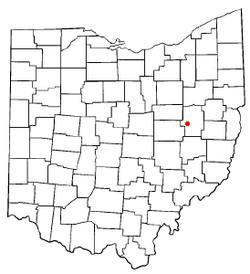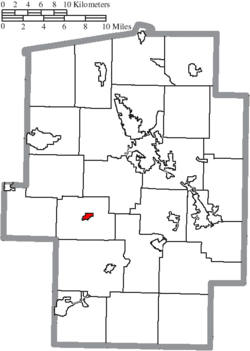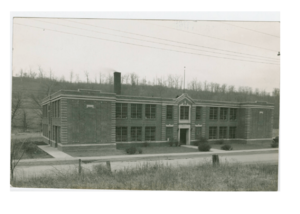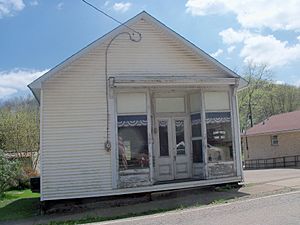Stone Creek, Ohio facts for kids
Quick facts for kids
Stone Creek, Ohio
|
|
|---|---|
|
Village
|
|
| Motto(s):
"A Small Town With A Big Heart
|
|

Location of Stone Creek, Ohio
|
|

Location of Stone Creek in Tuscarawas County
|
|
| Country | United States |
| State | Ohio |
| County | Tuscarawas |
| Township | Jefferson |
| Founded by | Phillip Leonhardt |
| Area | |
| • Total | 0.43 sq mi (1.10 km2) |
| • Land | 0.42 sq mi (1.10 km2) |
| • Water | 0.00 sq mi (0.00 km2) |
| Elevation | 922 ft (281 m) |
| Population
(2020)
|
|
| • Total | 153 |
| • Density | 360.00/sq mi (138.94/km2) |
| Time zone | UTC-5 (Eastern (EST)) |
| • Summer (DST) | UTC-4 (EDT) |
| ZIP code |
43840
|
| Area code(s) | 330 |
| FIPS code | 39-74804 |
| GNIS feature ID | 2399907 |
Stone Creek is a small village located in Tuscarawas County, Ohio, United States. In 2020, the village had a population of 153 people. It is known for its quiet, small-town feel.
Contents
Village History: How Stone Creek Began
Early settlers arrived in the Stone Creek valley around 1827. John Hawk was the first person to settle here. More people came because of the Ohio and Erie Canal built nearby. Most of these new settlers were of German background. Some came directly from Germany. Others were second or third generation German-Americans from Pennsylvania.
Even though the canal did not go through Stone Creek directly, it helped the area grow. It made it easier to ship farm products like wheat to eastern markets. This also made farm produce more valuable. This encouraged more people to settle in the area, as it was close to canal shipping points.
Naming Stone Creek Village
In the early days, a resident named Philip Burrier hauled many stones. He used them to build a path across the local creek. This path allowed horses and wagons to cross easily. Because of this, people started calling the creek "Stone Creek."
When a post office was set up in 1840, it was named Stone Creek. It was located on Michael Harmon's property.
From Phillipsburg to Stone Creek
The first try to create a town was in 1848. Adam Sherrets planned a site where Dott's Fork met Stone Creek. However, this attempt did not succeed.
The current village of Stone Creek was planned in 1854 by Philip Leonhart. He first named it Phillipsburg. Later, the name was changed to Stone Creek, matching the post office. The town grew slowly until the Cleveland & Marietta Railroad was built through it in the 1870s. This train line helped the village grow faster.
In 1904, village council members Charlie Kughler and Fred Haas traveled to Akron. They wanted to officially register the village. They found out that another Phillipsburg already existed in Ohio. So, they decided to name the village after the Stone Creek post office.
Stone Creek's School Days
Stone Creek once had its own school. It served the students of Jefferson Township. This school was formed by combining several smaller schoolhouses. One of these, the Angel Valley Schoolhouse, is still standing today.
The main Stone Creek-Jefferson school building was built in 1927. It operated on its own until 1965. At that time, the Ohio Department of Education required it to join a larger school district. It merged with the New Philadelphia City Schools.
After the merger, the Stone Creek school building became an elementary school. It was called "Stone Creek Elementary." It also had a steel and welding shop for high school students. These students were bused in from New Philadelphia High School for their classes. The school building closed in 1974. It was torn down on October 17, 1979.
Village Fire Department
Stone Creek still has its own volunteer fire department. It was officially started in 1949. However, the building itself is older than that. Before 1949, the town had a fire wagon. Community members would use this wagon to help fight fires.
Village Geography
Stone Creek is a small village. It covers a total area of about 0.43 square miles (1.10 square kilometers). All of this area is land.
Transportation in Stone Creek
Interstate 77 passes through Stone Creek. This is a major highway. Also, SR 751 begins in the village. These roads help connect Stone Creek to other places.
Village Population and People
| Historical population | |||
|---|---|---|---|
| Census | Pop. | %± | |
| 1910 | 144 | — | |
| 1920 | 133 | −7.6% | |
| 1930 | 225 | 69.2% | |
| 1940 | 214 | −4.9% | |
| 1950 | 225 | 5.1% | |
| 1960 | 226 | 0.4% | |
| 1970 | 171 | −24.3% | |
| 1980 | 150 | −12.3% | |
| 1990 | 181 | 20.7% | |
| 2000 | 184 | 1.7% | |
| 2010 | 177 | −3.8% | |
| 2020 | 153 | −13.6% | |
| 2021 (est.) | 151 | −14.7% | |
| U.S. Decennial Census | |||
Population in 2020
In 2020, the village of Stone Creek had 153 people. There were 62 households living there. The population density was about 411.6 people per square mile. There were 71 housing units in the village.
Population in 2010
In 2010, Stone Creek had 177 people. There were 65 households and 54 families. Most residents (97.7%) were White. A small number of residents were African American or from other backgrounds.
The average age in the village was 35.5 years old. About 24.3% of the residents were under 18 years old.
See also
 In Spanish: Stone Creek (Ohio) para niños
In Spanish: Stone Creek (Ohio) para niños



